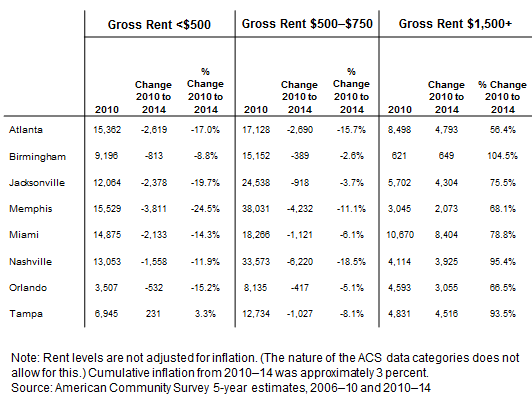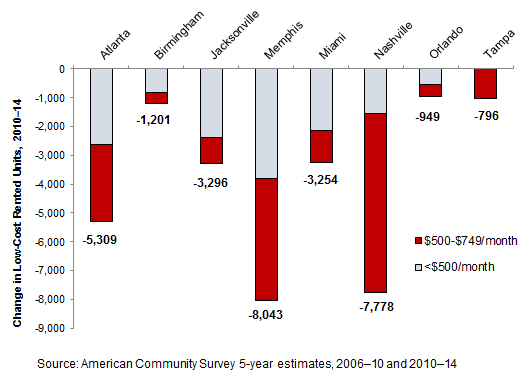
It's difficult to ignore the headlines about rising rents in America's coastal cities. In places like San Francisco and New York City, formerly working-class neighborhoods have been transformed into enclaves where only the wealthiest can afford to live. On the other hand, cities in the Southeast are often seen as relatively affordable compared to these pricey metropolises. But research from the Federal Reserve Bank of Atlanta's Community and Economic Development (CED) group shows that low-cost rented housing is increasingly out of reach for low- and moderate-income households in the Southeast. From Nashville to Miami, southeastern renters are feeling the pinch of an increasingly unaffordable market.
These are the findings of "Declines in Low-Cost Rented Housing Units in Eight Large Southeastern Cities," a new CED discussion paper by Dan Immergluck, Ann Carpenter, and Abram Lueders. The paper demonstrates that eight major cities in the Southeast have lost significant numbers of affordable housing units, and they've gained large numbers of luxury-priced rentals. The eight cities—Atlanta, Birmingham, Jacksonville, Miami, Nashville, Orlando, and Tampa in the Fed's Atlanta District and Memphis in the Fed's St. Louis District—each experienced declines in the number of low-cost units, with varying levels of magnitudes of change. Nashville, for example, lost 7,778 low-cost rental units in a four-year period while it gained almost 3,925 higher-cost units (see the table and figure).


The paper's findings are based on census tract-level data from the U.S. Census American Community Survey (ACS). Changes in units by gross rent categories were calculated between ACS five-year estimates for two periods: 2006–10 and 2010–14. Low-cost units were defined as those with rents under $750 a month (considered affordable for a household with an annual income of $30,000). Higher-cost units were defined as those with rents over $1,500 a month. Losses in low-cost rental units were scattered among neighborhoods within the studied cities. However, an analysis of tract-level data found that tracts with a younger population, newer housing stock, and low poverty rates experienced the largest losses in affordable housing.
There are many trends that could be contributing to the loss of low-cost rented units in the Southeast. First, aging low-cost rental housing is often abandoned once the cost of maintenance exceeds its potential rental income. Previously affordable rental units may be upgraded into luxury units as rental demand increases, while increased demand for land may make affordable housing cost-prohibitive. Some of the increase in higher-cost rentals may also include single-family homes that were converted into rental housing in the wake of the Great Recession. Together, these factors spell trouble for renters.
When rents rise, the financial burden on renters can take a severe toll. Housing experts typically agree that a household shouldn't have to spend more than 30 percent of its income on housing. Above this level, households are considered to be "cost-burdened." In the eight studied cities, more than 80 percent of households with incomes below $35,000 were paying over 30 percent of their income on housing. Additionally, over 50 percent of all households in these cities—regardless of income—were cost-burdened.
Maintaining a supply of affordable rental housing is an increasingly important goal for cities throughout the Sixth District. The nature of affordable housing loss varies from city to city, and successful mitigation strategies will have to take the unique dynamics of individual markets into account. But without thoughtful policy and investment, it's unlikely that the pattern of decreasing affordability can be halted. The findings and implications of this paper should provide a helpful starting point for stakeholders across the region engaged with this complex and crucial issue.



